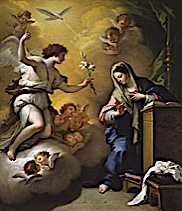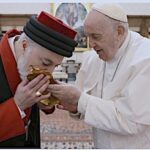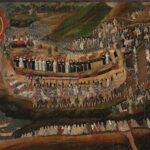Illustration: by artist Paolo de Matteis (1662–1728)
Cycle of Catechesis. The Spirit and the Bride. 13
The Holy Spirit leads God’s people to Jesus our hope. 13.
“Marian piety: to Jesus through Our Lady’s hands”
Acts of the Apostles Reflection (Acts 1:12-14)
12 Then they returned to Jerusalem from the mount called Olivet, which is near Jerusalem, a sabbath day’s journey away; 13 and when they had entered, they went up to the upper room, where they were staying, Peter and John and James and Andrew, Philip and Thomas, Bartholomew and Matthew, James the son of Alphaeus and Simon the Zealot and Judas the son of James. 14 All these with one accord devoted themselves to prayer, together with the women and Mary the mother of Jesus, and with his brethren.
Dear brothers and sisters,
Among the various means by which the Holy Spirit carries out his work of sanctification in the Church – The Word of God, The Sacraments, Prayer – there is one in particular and that is Marian Devotion.
In the Catholic tradition there is this motto, this saying: ‘Ad Iesum per Mariam’, that is, ‘to Jesus through Mary’. Our Lady makes us see Jesus. She opens doors for us, always!
Our Lady is the mother who takes us by the hand to Jesus.
Our Lady never point to herself, she points to Jesus.
And that is Marian devotion: to Jesus through the hands of Our Lady.
St Paul defines the Christian community as ‘a letter from Christ written by us, not with ink, but with the Spirit of the living God, not on tablets of stone, but on tablets of human hearts’ (2 Cor 3:3 1- 3 Are we beginning to commend ourselves again? Or do we need, as some do, letters of recommendation to you, or from you? 2 You yourselves are our letter of recommendation, written on your hearts, to be known and read by all men; 3 and you show that you are a letter from Christ delivered by us, written not with ink but with the Spirit of the living God, not on tablets of stone but on tablets of human hearts.).
Mary, as the first disciple and model of the Church, is also a letter written with the Spirit of the living God.
It is precisely for this reason that she can be ‘known and read by all men’ (2 Cor 3:2 – You yourselves are our letter of recommendation, written on your hearts, to be known and read by all men), even by those who cannot read theological books, by those ‘little ones’ to whom Jesus that says the mysteries of the Kingdom, hidden from the wise, will be revealed (cf. Mt 11:25 – At that time Jesus declared, “I thank thee, Father, Lord of heaven and earth, that thou hast hidden these things from the wise and understanding and revealed them to babes;).
By saying her ‘yes’ – when Mary accepts and says to the angel: ‘yes, let the Lord’s will be done’ and accepts to be the mother of Jesus -, it is as if Mary were saying to God: ‘Here I am, I am a writing tablet: let the writer write what he wants, let the Lord of all things do with me’ [2].
In those days, people wrote on waxed tablets; today we would say that Mary offers herself as a blank page on which the Lord can write what he wants.
Mary’s ‘yes’ to the angel – a well-known exegete has written – represents ‘the summit of all religious behavior before God, because it expresses in the highest manner, passive availability combined with active readiness, the deepest emptiness that accompanies the greatest fullness’.
Here, then, is how the mother of God is an instrument of the Holy Spirit in his work of sanctification.
In the midst of the infinite profusion of words spoken and written about God, the Church and holiness (which very few, if any, are able to read and understand in their entirety) she proposes just two words that everyone, even the simplest, can pronounce on any occasion: ‘Here I am’ and ‘fiat’. Mary is the one who said ‘yes’ to the Lord and by her example and intercession urges us to say our ‘yes’ to Him too, whenever we are faced with an obedience to be performed or a trial to be overcome.
At all times in its history, but especially at this moment, the Church is in the situation of the Christian community after the aftermath of Jesus’ Ascension.
It must preach the Gospel to all nations, but it is waiting for the ‘power from on high’ to be able to do so.
And let us not forget that at that moment, as we read in the Acts of the Apostles, the disciples were gathered around ‘Mary, the mother of Jesus’ (Acts 1:14 above).
It is true that there were also other women with her in the Cenacle, but her presence is different and unique among them all.
Between her and the Holy Spirit there is a unique and eternal bond which is the person of Christ himself, ‘conceived by the Holy Spirit and born of the Virgin Mary’, as we say in the Creed.
The evangelist Luke deliberately emphasizes the correspondence between the coming of the Holy Spirit upon Mary at the Annunciation and his coming upon the disciples at Pentecost, using some identical expressions in both cases.
St Francis of Assisi, in one of his prayers, callls the Virgin ‘Daughter and Handmaid of the Most Holy King, the heavenly Father, mother of the most holy Lord Jesus Christ, spouse of the Holy Spirit’ [4]. Daughter of the Father, Mother of the Son, Bride of the Holy Spirit!
There is no simpler way of expressing Mary’s unique relationship with the Trinity.
Like all images, this one of the ‘Bride of the Holy Spirit’ should not be absolutized, but taken for the amount of truth it contains, and it is a very beautiful truth.
Mary is the bride, but first of all, she is the disciple of the Holy Spirit.
Bride and disciple.
Let us learn from her to be docile to the inspirations of The Spirit, especially when He suggests we ‘get up quickly’ and go to help someone in need, as she did immediately after the angel left her (cf. Lk 1:39 – In those days Mary arose and went with haste into the hill country, to a city of Judah).
Thank you!
Summary
In our continuing catechesis on the Holy Spirit in the life of the Church, we now consider the Spirit’s unique relationship with the Blessed Virgin Mary.
In the Spirit’s work of leading us to Jesus, Our Lady plays a privileged role.
St. Francis of Assisi once described Mary as the Spouse of the Holy Spirit, since by her fiat – her “yes” to the Father’s plan – she became the mother of the incarnate Son of God.
Filled with the Spirit, Our Lady became the first disciple of the Lord and the model of all Christian discipleship.
Through her maternal presence and intercession, may she teach us to be docile like her to the promptings of the Spirit, to seek God’s will in prayer and to go forth in charity to meet the needs of our brothers and sisters.


